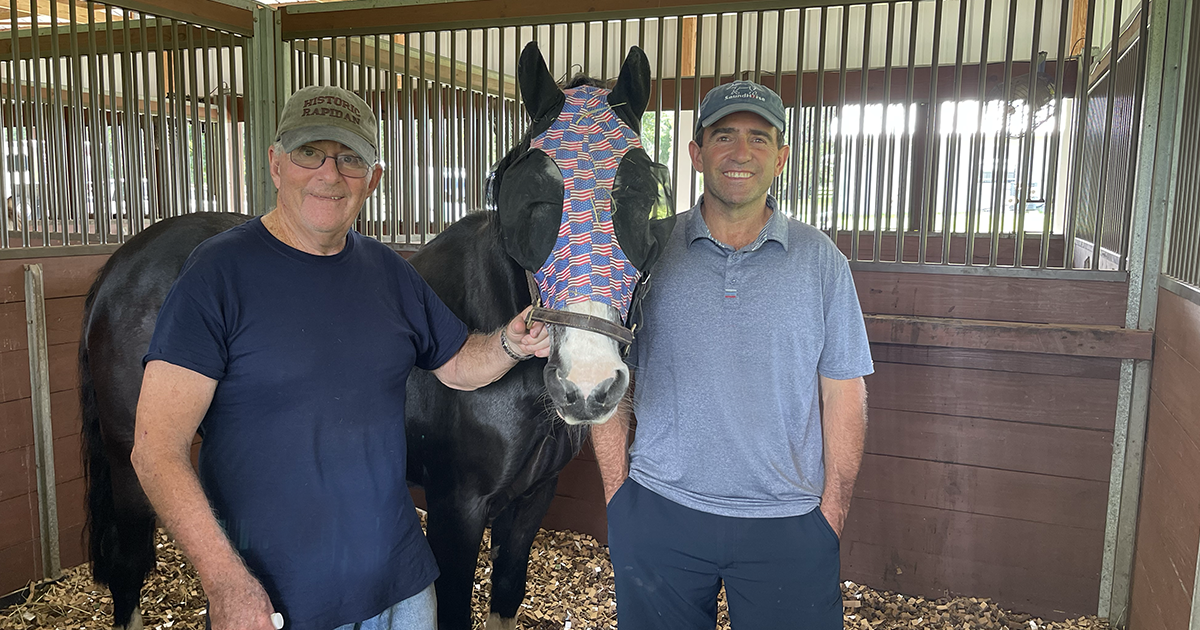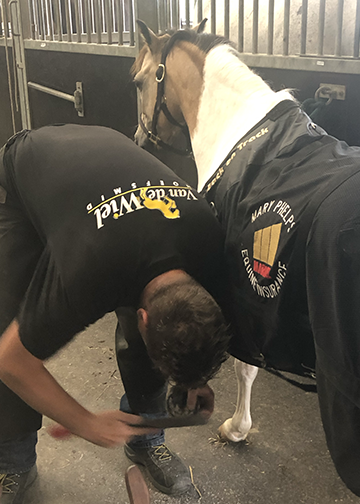Key Factors Concerning Laminitis With Dr. Brett Barrett , DVM, CJF
Friday, June 23, 2023 | Dr. Brett Barrett DVM

Dr. Brett Barrett, DVM, CJF is a veterinarian and an American Farrier’s Association certified journeyman with over 20 years experience. Barrett Equine Podiatry Services is his referral-based practice in Ocala, Fla.
Bouncer’s Story

Suzy Stafford with Wayne Humphreys winning Gold at the 2005 FEI World Driving Championships-for Ponies
When Cefnoakpark Bouncer, the 2005 Pony Driving World Champion suffered a severe case of laminitis in 2019 at the age of 24 his owner Wayne Humphreys was not ready to give up on him. Neither was Dr. Barrett.
This condition affects the tissues (laminae) bonding the hoof wall to the pedal bone in the hoof. This can result in the pedal bone sinking or rotating within the hoof under the weight of the horse.With over a 15 degree rotation of the pedal bone, and a severe case of white line, also known as “seedy toe” causing the toe of Bouncer’s two front feet to crumble, Dr. Barrett had his work cut out for him.
Using his knowledge and skill as both a veterinarian and farrier, Dr. Barrett created special padded shoes on a four week cycle. Now three years later Barrett’s farrier assistant Jacob Bruckner stops by every six weeks.
The 27 year old pony still enjoys regular drives on his farm in Ocala.
A Shift in His Practice
Recently Barrett has made a shift in his practice from acute laminitis cases to focussing on equine lameness. He admits it’s been hard. “Laminitis is a sometimes brutal disease, and it is not curable,” he said, “but it can be manageable.” He has begun to develop a series of articles sharing what he has learned, and continues to learn in his 20 years experience helping horses and their humans deal with this dreaded disease.
“Laminitis is on the rise right now, ” noted Barrett. “Almost all of the laminitis cases I’ve worked on are metabolic meaning they either have PPID (cushings) or insulin resistance/disregulation. If your horse can be described as an easy keeper they most likely have an insulin issue. It’s rare, but cushings can occur in horses as young as seven, but it does.”

Wayne Humphreys with Bouncer in the Vet Clinic getting special shoes
Knowing the Signs
Depending on many variables, a large percentage of metabolic horses are primed for a bout of laminitis set off by a number of causes. Dr. Barrett outlines a list of some of those causes horse owners and caregivers may not be aware of.
“I’m not saying if your horse receives any of these they are necessarily going to become laminitic, it’s just a list of things to consider.”
- Steroids: this includes joint injections, allergy and autoimmune disease treatment, and treatment of soft tissue injuries. Triamcinolone (vetalog or kenalog) and dexamethasone are the two biggest culprits.
- Vaccines: even a mild reaction can affect them. I typically try to split up my vaccines when possible especially on laminitic prone horses. I feel 5 way vaccines carry a higher risk.
- Colic: yes even a mile bout of colic can be a trigger. Surgical cases carry even a higher risk.
- General anesthesia from either a surgical or a diagnostic procedure.
- Any illness that produces a fever
- Grass! This is probably the biggest culprit. How much exposure your horse can have to grass as dependent on many things. Some horses it boils down to the fact that they cannot be on grass at all here in Florida.
- Any bout of stress such as losing a pasture mate or being shipped to a new location can be a problem. Especially if it causes excessive running.
- Excessive protein in the diet can be converted to sugar if not utilized. Excess sugar produces a spike in insulin which can be problematic.
- Ulcers whether they are stomach or hind gut, in addition to other hind gut issues can affect the metabolic system. This most likely applies more to re-occurrence on chronic cases versus acute.
- Endotoxic insults from conditions such as pneumonia, retained or infected placentas, and even cellulitis.

Henneke Body Scoring System for Horses
Recommendations
If at all in doubt, Dr. Barrett highly recommends annual radiographs and a full metabolic panel. There are several tests more advanced than the simple baseline which is often normal that may provide additional insight.This may help identify problems before they occur and aid in proper management.
I highly encourage everyone to look at the body condition scoring system I have posted. Then go look at your horse. If they are 6 or above there is probably reason for concern.
The Cure Lies in Prevention
“We are highly focused on the treatment for laminitis. Not to be cliche, but for me the cure lies in the prevention. Once laminitis is already underway it presents management challenges and may be difficult to treat. I understand this is only a tiny portion of all the things that could be discussed. My attempt here is simply to increase awareness.
Some Good References
Dr.Vern Dryden has developed a stall-side insulin testing kit that is very beneficial.
This is the link for his website
https://wellnessready.com
Another good resource is linked here
https://www.ecirhorse.org

















